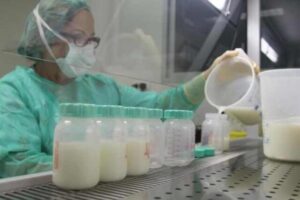
More than 2,800 newborn children with low birth weight, or prevented from breastfeeding due to certain pathology with surgical intervention, benefited from the services of the Sonrisas del Mañana Human Milk Bank at the Doctor Agostinho Neto Teaching General Hospital, in Guantanamo.
Since its opening on May 1, 2011 to date, the facility has processed 3,460 liters of the vital food voluntarily donated by 13,628 Guantanamo mothers, reported Nursing Adalidia Leyva Crespo, responsible for caring for puerperal women in the largest care center in the Cuban easternmost province.
Most of the contributions came from donors in the five Health areas of the main municipality, which were stored in the Milk Bank set up in the Emilio Daudinot Bueno Polyclinic (Northern area) and then transported to the provincial hospital.
During the aforementioned stage, the Milk Bank also provided counseling and assistance services to 25,936 mothers affected by various ailments, including mastitis (inflammation in the breast), fever, cracked nipples, and breast engorgement (hard breast).
Leyva Crespo, founder of the center, stressed that breast milk is the ideal food for a baby during its first months of life, as it has a high nutritional value and is easier to digest.
Due to its immunological importance, it is considered the first vaccine received by the child, which has an impact on the reduction of infant morbidity-mortality caused by diarrheal and acute respiratory diseases.
The Human Milk Bank in Guantanamo is the result of the collaboration of the United Nations Children’s Fund (UNICEF) equipped at a cost of 26 thousand dollars and around 10 thousand pesos in national currency.
It has a milking parlor, a laboratory for biochemical examination and an area with optimal conditions for storing the breast milk extracted from mothers who had recently given birth and, once the safe extraction of milk has been determined, it is pasteurized and stored for use.
In this process, all germs are eliminated, including the Human Immunodeficiency Virus that causes AIDS, while the liquid preserves all its nutrients and immunological factors for six months frozen.
Research related to breastfeeding and infant survival indicates that the risk of dying from any disease is almost double in non-breastfed infants.
The World Health Organization recommends this procedure as an exclusive way of feeding infants during the first six months of life and can extend up to two years or more, to strengthen the affective bond with the mother, complemented with other safe foods[/bg_collapse]